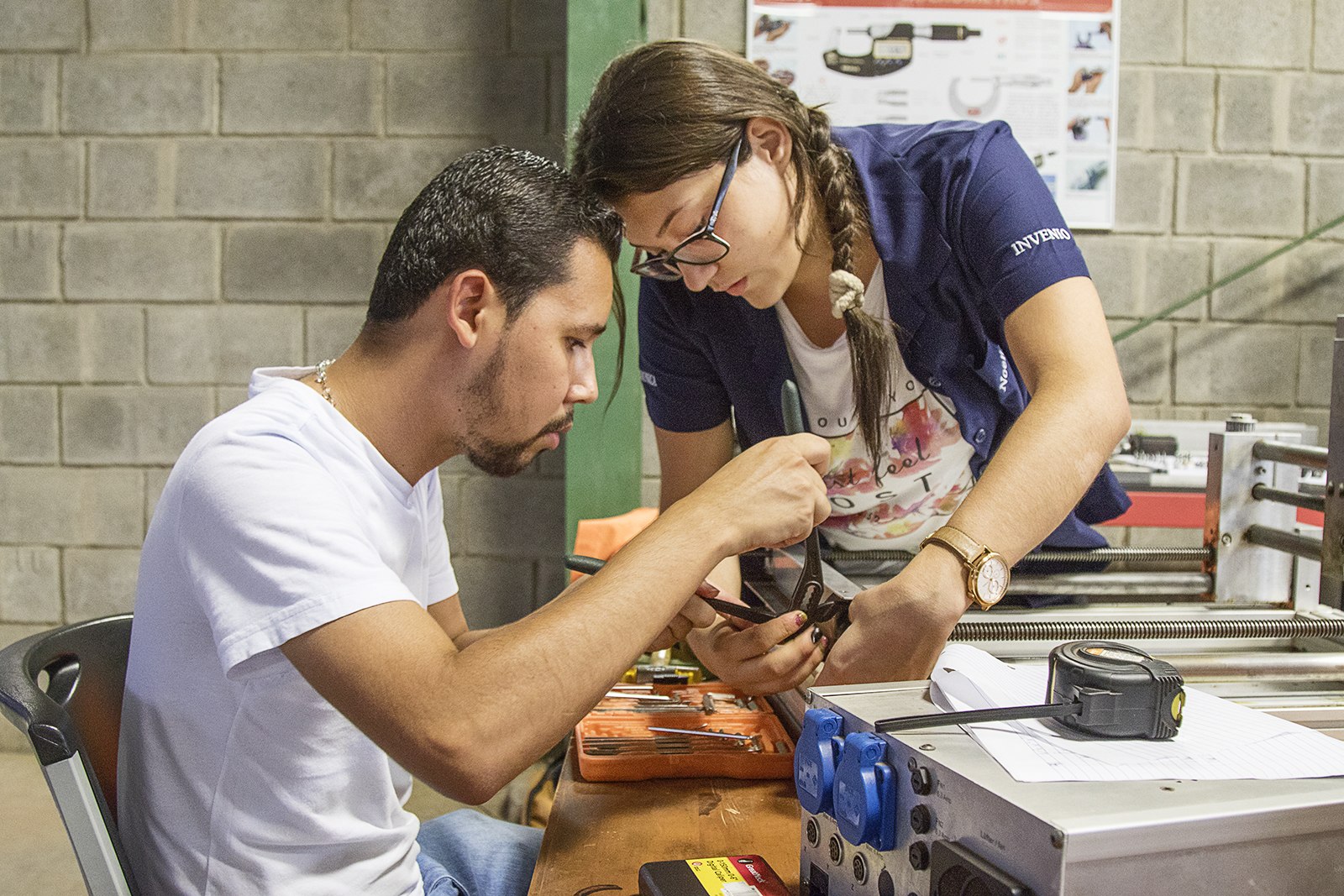
What’s in Guanacaste? The immediate answer is that there are major tourism investments, huge agricultural and livestock production and a lot of fishing, but now there is a new economic activity that emerges, tests and explores possibilities: technology.
The growth of technology-related companies in Guanacaste has not been excessive, but it is slow and steady. In 2014, the Chamber of Information and Communication Technology (Camtic- Cámara de Tecnología de Información y Comunicación) mapped out 219 technology companies nationwide. However, only four (representing 1.8%) appeared in the province.
Nonetheless, the private non-profit organization Cinde, which is responsible for attracting investment in the country, has identified nine companies dedicated to technology in the Chorotega region, of which Ad Astra and Avantica stand out, and this year, Canadian company Gildan is setting up operations there as well.

Noelia Blanco and Angel Vallejos assemble a router as their dual project for Mechatronics Studies at Invenio University in Cañas.
Ad Astra Rocket Company is an aerospace engineering company dedicated to developing advanced propulsion technologies based on plasma, while Avantica is dedicated to engineering software. Meanwhile, Gildan is a fabric factory that implements technology for athletic pieces.
Carlos Murillo, Director of the Daniel Oduber campus of EARTH University, thinks Guanacaste has every possibility of attracting development, first of all because it is an area where there is great exploitation of several different types of energy.
“Guanacaste has all of the energy in the world. We have solar energy that we’re just barely testing, we have wind, geothermal, and hydroelectric energy. We have oceans that have energy capacity and everything humans do today depends on energy, from the energy used by your cell phone, car, house, industry— everything is energy and behind this energy, there are great advances in technology,” Murillo explained.
On 28 March, with President Luis Guillermo Solis present, an agreement was signed in Liberia between EARTH University and Ad Astra to develop clean energy based on hydrogen and to do a pilot plan. That pact has the support of the Development Banking System, which will invest $432,000.
Internationally, hydrogen is considered a fuel of the future due to its environmental benefits and due to the various possibilities for using it. In Costa Rica, the country is 70% dependent on hydrocarbon (like oil), so this practicum will help diversify energy.
In the Guanacaste highlands, large projects are also envisioned. According to Adrian Lachner, director of Invenio University, dedicated to preparing and training technology professionals, they plan on building a free trade zone in Cañas across from the institution, focused on technology research and development.
The 10,000-square-meter (107,600-square-foot) project would generate about 300 jobs, and already has the support of the Presidency and of the Foreign Trade Promoter (PROCOMER- Promotora de comercio Exterior). However, the project has been delayed because of the bank loan since they need $2 million.
“The business potential in technological services is bigger than people imagine. Uber is a bigger company than General Motors and Ford together. In technology, the limit is much higher. I believe that there is a great opportunity in Guanacaste. It is not guaranteed, but it is an opportunity,” Lachner commented.

At Invenio University, they offer undergraduate degrees in information technology and business communication, mechatronics engineering and industrial engineering with an emphasis on operations.
What is Sexy about Guanacaste
Investing in companies dedicated to technology in Guanacaste is not a far-fetched idea for foreign companies or companies based in the Central Valley. On the contrary, the province of Guanacaste is in better shape than the Greater Metropolitan Area (GAM- Gran Área Metropolitana) and the costs are lower, plus there is more space for construction.
To the Scientific Director of Ad Astra, Jose Castro Nieto, one of the main advantages that they had when setting up operations in Guanacaste in 2006 was the quality of life that the company’s 11 employees have.
“I think the big advantage that we have being here is the life that we employees have living here. It might sound intangible. Also now we are putting together projects based around renewable energy. Being in Guanacaste has benefits, since solar radiation is quite good, the quality of wind power is quite good, but most important is the quality of my life and that of my colleagues. The peace, the traffic, the environment and the contact with nature are things that are being lost in the metropolitan area,” Castro stated.
The expert also pointed out that since Guanacaste is a tourist area, it is common to find a larger bilingual population. However, an effort should be made to improve technical English for professionals since there are shortcomings in this category.
Challenges and Adversities
“I always ask why high-tech companies that are in the metropolitan area can’t come here. Many of the answers that I have received relate to human resources, how many people are trained in the region. University education has to be much stronger,” affirmed the director of Ad Astra.
In Guanacaste, the National University, the University of Costa Rica, the Technological Institute and Invenio University all train professionals in technology areas. However, the majority of students move to the capital.
To Castro, the current situation being experienced is like “the chicken and the egg” because, to have more professionals, there need to be more companies, but for there to be companies, there has to be professionals, so he recommends that investors take the risk and bet on the area. In this way, many Guanacastecans won’t migrate and more people from San Jose will be attracted to work in the region.
Christian Nuñez, coordinator of the Science and Technology Entrepreneurship Camp, a program that links young college and university students with technology and entrepreneurship, added that technical schools in Guanacaste face one of the challenges since they must reinvent themselves with programs that are more competitive, tackling innovation and entrepreneurship.
“The professors do not feel committed to developing innovation projects in science and technology since they imagine that it is expensive and difficult. That is something that we are trying to get out of their minds. We have technology within reach. I think it’s something we have as Ticos in rural areas— we come with the “poor little things” chip [embedded in us] because those in San Jose can do it and do have it, but what do they have and what can they do if we are all the same,” Nuñez said.
The director of EARTH University added that university programs should focus more on water technologies and renewable energy technologies since they are needs in the province.
Looking Towards the Future
Students in the Invenio University classrooms, many of whom are from Guanacaste, are surrounded by machines, computers, drones, chips, circuits and pieces of metals or plastics. Mathematical calculations and physics theories are written on the boards. It shows that they are in their field, happy.
And the environmental future of the province might lie in these youths because, without a doubt, the technological growth in Guanacaste will be an answer to the challenges of climate change. The Guanacaste economy based on agriculture and livestock will not be profitable in a few years. Its water consumption is immense. But if the province adapts an economic model with a focus on technology, the new climate conditions could be taken advantage of.
Like everything else, planning is paramount. According to experts, if the province does not prepare hand in hand with development, it could have big problems regarding saturation of roads, lack of services and insecurity.







Comments